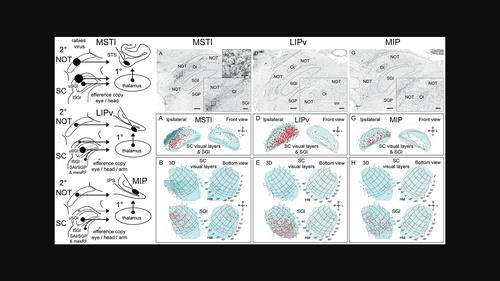当前位置:
X-MOL 学术
›
Eur. J. Nerosci.
›
论文详情
Our official English website, www.x-mol.net, welcomes your feedback! (Note: you will need to create a separate account there.)
Pathways from the superior colliculus and the nucleus of the optic tract to the posterior parietal cortex in macaque monkeys: Functional frameworks for representation updating and online movement guidance
European Journal of Neroscience ( IF 3.4 ) Pub Date : 2024-03-28 , DOI: 10.1111/ejn.16314 Gabriella Ugolini 1 , Werner Graf 2
European Journal of Neroscience ( IF 3.4 ) Pub Date : 2024-03-28 , DOI: 10.1111/ejn.16314 Gabriella Ugolini 1 , Werner Graf 2
Affiliation

|
The posterior parietal cortex (PPC) integrates multisensory and motor‐related information for generating and updating body representations and movement plans. We used retrograde transneuronal transfer of rabies virus combined with a conventional tracer in macaque monkeys to identify direct and disynaptic pathways to the arm‐related rostral medial intraparietal area (MIP), the ventral lateral intraparietal area (LIPv), belonging to the parietal eye field, and the pursuit‐related lateral subdivision of the medial superior temporal area (MSTl). We found that these areas receive major disynaptic pathways via the thalamus from the nucleus of the optic tract (NOT) and the superior colliculus (SC), mainly ipsilaterally. NOT pathways, targeting MSTl most prominently, serve to process the sensory consequences of slow eye movements for which the NOT is the key sensorimotor interface. They potentially contribute to the directional asymmetry of the pursuit and optokinetic systems. MSTl and LIPv receive feedforward inputs from SC visual layers, which are potential correlates for fast detection of motion, perceptual saccadic suppression and visual spatial attention. MSTl is the target of efference copy pathways from saccade‐ and head‐related compartments of SC motor layers and head‐related reticulospinal neurons. They are potential sources of extraretinal signals related to eye and head movement in MSTl visual‐tracking neurons. LIPv and rostral MIP receive efference copy pathways from all SC motor layers, providing online estimates of eye, head and arm movements. Our findings have important implications for understanding the role of the PPC in representation updating, internal models for online movement guidance, eye‐hand coordination and optic ataxia.
中文翻译:

猕猴从上丘和视束核到后顶叶皮层的通路:表示更新和在线运动指导的功能框架
后顶叶皮层(PPC)整合多感觉和运动相关信息,用于生成和更新身体表征和运动计划。我们在猕猴中使用狂犬病病毒的逆行跨神经元转移与传统示踪剂相结合,以确定通往手臂相关的头端内侧顶内区(MIP)、腹侧外侧顶内区(LIPv)(属于顶叶眼区)的直接和非突触途径。 ,以及与追踪相关的内侧上颞区(MSTl)的横向细分。我们发现这些区域通过丘脑从视束核(NOT)和上丘(SC)接收主要的突触通路,主要是同侧。 NOT 通路主要针对 MST1,用于处理缓慢眼球运动的感觉后果,其中 NOT 是关键的感觉运动接口。它们可能导致追踪和视动系统的方向不对称。 MSTl 和 LIPv 接收来自 SC 视觉层的前馈输入,这些输入对于运动的快速检测、感知扫视抑制和视觉空间注意力是潜在的关联。 MST1 是来自 SC 运动层的扫视和头部相关区室以及头部相关网状脊髓神经元的传出复制通路的目标。它们是 MSTl 视觉跟踪神经元中与眼睛和头部运动相关的视网膜外信号的潜在来源。 LIPv 和吻侧 MIP 接收来自所有 SC 运动层的输出复制路径,提供眼睛、头部和手臂运动的在线估计。我们的研究结果对于理解 PPC 在表征更新、在线运动指导的内部模型、眼手协调和视共济失调中的作用具有重要意义。
更新日期:2024-03-28
中文翻译:

猕猴从上丘和视束核到后顶叶皮层的通路:表示更新和在线运动指导的功能框架
后顶叶皮层(PPC)整合多感觉和运动相关信息,用于生成和更新身体表征和运动计划。我们在猕猴中使用狂犬病病毒的逆行跨神经元转移与传统示踪剂相结合,以确定通往手臂相关的头端内侧顶内区(MIP)、腹侧外侧顶内区(LIPv)(属于顶叶眼区)的直接和非突触途径。 ,以及与追踪相关的内侧上颞区(MSTl)的横向细分。我们发现这些区域通过丘脑从视束核(NOT)和上丘(SC)接收主要的突触通路,主要是同侧。 NOT 通路主要针对 MST1,用于处理缓慢眼球运动的感觉后果,其中 NOT 是关键的感觉运动接口。它们可能导致追踪和视动系统的方向不对称。 MSTl 和 LIPv 接收来自 SC 视觉层的前馈输入,这些输入对于运动的快速检测、感知扫视抑制和视觉空间注意力是潜在的关联。 MST1 是来自 SC 运动层的扫视和头部相关区室以及头部相关网状脊髓神经元的传出复制通路的目标。它们是 MSTl 视觉跟踪神经元中与眼睛和头部运动相关的视网膜外信号的潜在来源。 LIPv 和吻侧 MIP 接收来自所有 SC 运动层的输出复制路径,提供眼睛、头部和手臂运动的在线估计。我们的研究结果对于理解 PPC 在表征更新、在线运动指导的内部模型、眼手协调和视共济失调中的作用具有重要意义。



























 京公网安备 11010802027423号
京公网安备 11010802027423号